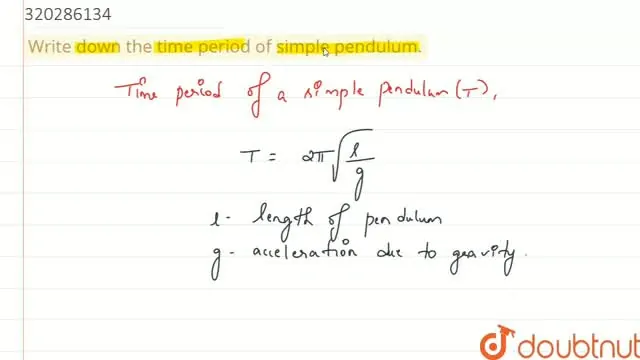Write down the time period of simple pendulum. Solution in Tamil
A pendulum is a mechanical system which exhibits periodic motion. It has a bob with mass m suspended by a long string (assumed to be massless and inextensible string) and the other end is fixed on a stand as shown in Figure (a). At equilibrium, the pendulum does not oscillate and hangs vertically downward. Such a position is known as mean position or equilibrium position. When a pendulum is displaced through a small displacement from its equilibrium position and released, the bob of the pendulum executes to and fro motion. Let 1 be the length of the pendulum which is taken as the distance between the point of suspension and the centre of gravity of the bob. Two forces act on the bob of the pendulum at any displaced position, as shown in the Figure (d),

Normal component: The component along the string but in opposition to the direction of tension, Fas=mgcosθ.
Tangential component: The component perpendicular to the string i.e., along tangential direction of arc of swing, Fps=mgsinθ.
Therefore, the normal component of the force is , along the string, T−Was=mv2l
Here v is speed of bob
T−mgcosθ=mv2l ...(1)
From the Figure we can observe that the tangential component Wps of the gravitational force always points towards the equilibrium position i.e., the direction in which it always points opposite to the direction of displacement of the bob from the mean position. Hence, in this case, the tangential force is nothing but the restoring force. Applying Newton's second law along tangential direction, we have
md2sdt2+FPs=0⇒md2sdt2=−FPs
md2sdt2=−mgsinθ ...(2)
where, s is the position of bob which is measured along the arc. Expressing are length in terms of angular displacement i.e.,
s=lθ ...(3)
then its acceleration,
dsdt2=ld2θdt2 ...(4)
Substituting equation (4) in equation (2), we get
ld2θdt2=−gsinθ
d2θdt2=−glsinθ ...(5)
Because of the presence of sinθ in the above differential equation, it is a non-linear differential equation (Here, homogeneous second order). Assume "the small oscillation approximation", sinθ≈θ, the above differential equation becomes linear differential equation.
d2θdt2=−glθ ...(6)
This is the well known oscillatory differential equation. Therefore, the angular frequency of this oscillator (natural frequency of this system) is
ω2=gl⇒ω=√gl in rads−1
The frequency of oscillations is
f=12π√gl in Hz
and time period of oscillations is T=2π√lg in second.
Related Playlists
- BOOK - SURA PUBLICATIONCHAPTER - GOVT. MODEL QUESTION PAPER - 2EXERCISE - PART - III (Answer the questions)9videos
GOVT. MODEL QUESTION PAPER - 2
- BOOK - SURA PUBLICATIONCHAPTER - GOVT. MODEL QUESTION PAPER - 1EXERCISE - PART - IV19videos
GOVT. MODEL QUESTION PAPER - 1
- BOOK - SURA PUBLICATIONCHAPTER - GRAVITATIONEXERCISE - VALUE BASED QUESTIONS4videos
GRAVITATION
Similar Questions
Convert 76cm of mercury pressure into Nm−2 using the method of dimensions.
08:38View SolutionObtain an expression for the time period T of a simple pendulum. [The time period T depend upon (i) mass l of the bob (ii) length m of the pendulum and (iii) acceleration due to gravity g at the place where pendulum is suspended.
Assume the constant k=2π]02:01View SolutionJagaseesh was rotating a stone tied to an elastic rubber band. As time passes he kept on increasing its speed of rotation. As the speed increased, the length (i.e. radius) of the band was also increasing. His father Mr. Sridhar watched this and called Jagadeesh. When Jagadeesh came near by his father rotating the stone tied to the elastic band, he asked how this happened?
(i) State Keper's III law and give an expression.02:38View SolutionWhat is a simple pendulum? Find an expression for the time period and frequency of a simple pendulum.
View SolutionA simple pendulum is oscillating in a lift. If the lift is going down with constant velocity, the time period of the simple pendulum is T1. If the lift is going down with some retardation its time period is T2, then
01:30View SolutionTime period of simple pendulum increase with
01:30View SolutionWrite down the time period of simple pendulum .
01:57View SolutionWrite down the time period of simple pendulum.
04:55View SolutionWrite down the time period of simple pendulum.
01:25View SolutionWrite the formula for the periodicity of the simple pendulum.
View SolutionWhat is simple pendulum? Deduce an expression for the time period of simple pendulum.
01:30View SolutionThe time period of a simple pendulum is proportional to
01:32View Solutionसरल लोलक का आवर्तकाल गोलक के द्रव्यमान पर निर्भर -
03:23View SolutionWhat will be the effect on the time period of a simple pendulum if the amplitude of the simple pendulum is doubled?
01:55View Solutionसरल लोलक का आवर्तकाल गोलक के द्रव्यमान पर निर्भर करता है।
View SolutionWhat is a simple pendulum? Find an expression for the time period and frequency of a simple pendulum.
View Solution


